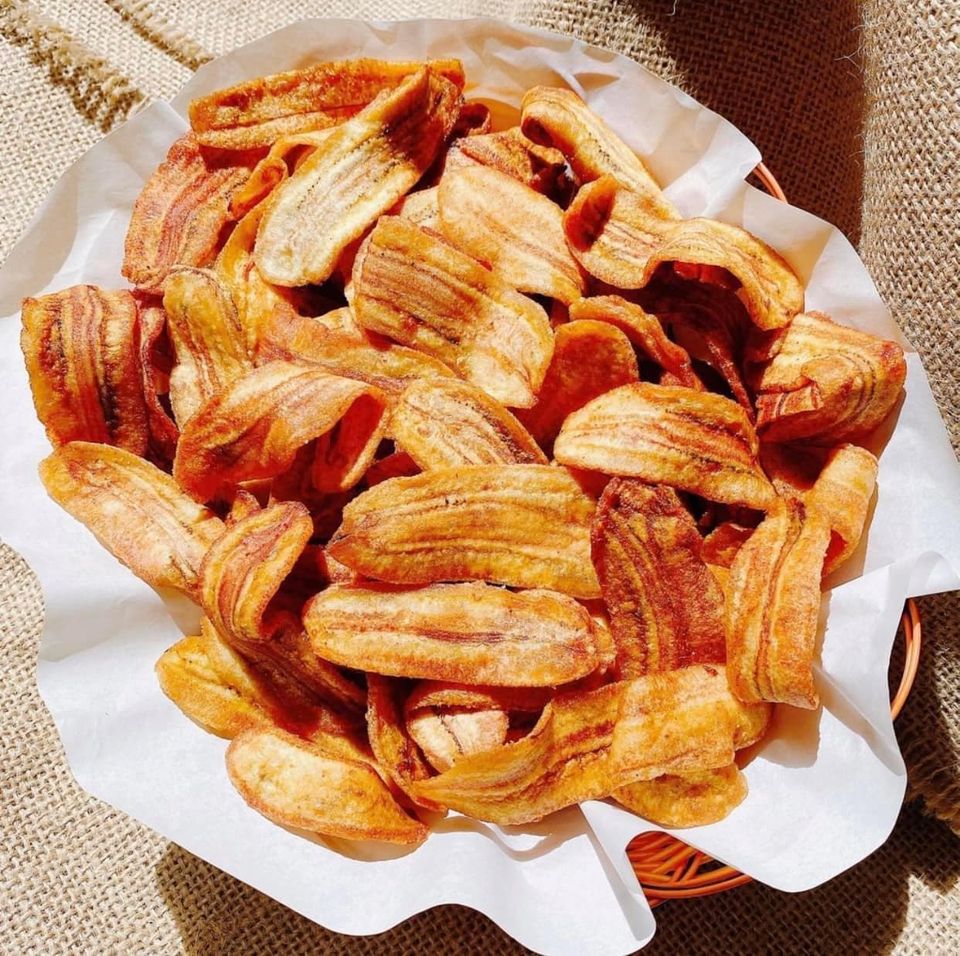
Vietnamese bananas are extremely popular in the country, being a part of street snacks and family dinners. These Vietnamese fruits are also famed for their many uses outside of the culinary world, making them one of Vietnam’s signature fruits. Here, we will learn about many types of banana in Vietnamese cuisine, their benefits, and where to buy them for yourself.
1. Health benefits of Vietnamese bananas
Vietnamese bananas provide a significant portion of your daily nutrient requirements, promoting multiple health benefits:
- Rich in vitamins and minerals: Vietnamese bananas contain significant amounts of vitamins, especially vitamin C and B6, as well as minerals like potassium and magnesium. These nutrients help enhance the immune system, improving your overall health. Additionally, they also promote heart and bone health.
- Having high fiber content: The fiber in bananas can aid digestion and play a vital role in improving skin health. Aside from that, helping with weight management is also a Vietnamese banana benefit.
- Having a considerable amount of antioxidants: Antioxidants in Vietnamese bananas can do wonders for the body, protecting it from various diseases.

2. List of popular types of bananas in Vietnam
Vietnamese bananas come in many types, each with their unique tastes, appearances, and uses. They may look rather similar at first glance, except for a few outstanding types, but there are some stark contrasts when you learn more about them. These are the most popular types of bananas in Vietnam:
- Chuoi tieu: This banana is slightly curved with two main variations: long and short. The peel is green if unripe and yellow when ripe. It is frequently used in cooking, making beverages, or snacking. Price: 22,000 VND/kilogram.
- Chuoi ngu: This banana is very similar to chuoi cau but larger with a sweeter taste. Its name derives from it being a usual offering to kings back in the day. Price: 35,000 VND/kilogram.
- Chuoi su: There are two types of chuoi su: white and green. It has a mildly sweet and tangy taste, perfect for traditional Vietnamese rolls. Price: 22,000 VND/kilogram.
- Chuoi cau: These are small and somewhat round Vietnamese bananas with a sweet taste and pleasant aroma, ideal for snacking. Price: 32,000 VND/kilogram.
- Chuoi sap: This banana slightly resembles chuoi su but rounder and marginally smaller. Its peel is often covered with dark spots and gives off a sweet scent when ripe. Keep in mind that it can only be served cooked. Price: 18,000 VND/kilogram.
- Chuoi bom: The locals often enjoy high production yield of these Vietnamese bananas, so it is predominantly used as cattle food thanks to the low cost. Price: 13,000 VND/kilogram.
- Chuoi Laba: Originated from Lam Dong, these Vietnamese bananas are known for their golden color, thick peel, and naturally sweet taste. Price: 32,000 VND/kilogram.
- Chuoi gia huong: This banana differentiates itself from other types with its large size and distinctive appearance, being one of the few types that turn green when ripe. Price: 36,000 VND/kilogram.
- Chuoi tao qua: It is rather hard to find these Vietnamese bananas as the locals are facing production difficulties. Chuoi tao qua is significantly larger than most other types. Similar to chuoi sap, it cannot be served raw. Price: 10,000 VND/banana.
- Chuoi cha bot: As a signature fruit of the Mekong Delta region, this type of Vietnamese bananas is characterized by its pleasant taste and satisfying texture. Price: 34,000 VND/kilogram.
- Chuoi cau lua: Sporting a unique red color, these Vietnamese bananas pique the interest of locals and tourists alike. Price: 35,000 VND/kilogram.
- Chuoi hot: This banana has a lot of seeds, which explains the name. Price: 23,000 VND/kilogram.

3. Famous foods made from Vietnamese bananas
Vietnamese bananas play a prominent role in the country’s cuisine, featured in both sweet and savory dishes. The fruit's flavor and texture add a distinct touch that mesh incredibly well with Vietnam’s signature treats. Its natural sweetness makes it one of the staple ingredients for desserts, snacks, and beverages.
3.1. Vietnamese grilled banana wrapped in sticky rice (Chuối nếp nướng)
Vietnamese grilled banana wrapped in sticky rice is a delightful dessert that has become one of the most iconic street food items in the country. The idea behind this dish is simple, doubling down on the glutinous texture of banana with rice and adding the charred flavors on the grill. The rice is cooked with coconut milk, further enhancing the fragrance of the dish.
Additionally, the sugar in Vietnamese bananas allows them to caramelize beautifully. When served with coconut milk, the dish becomes a harmonious blend of sweet and creamy notes. You can find this Vietnamese banana dessert almost anywhere at only around 20,000 VND/portion.

3.2. Vietnamese banana cake (Bánh chuối)
Vietnamese banana cake is a delectable treat with many different ways to prepare. Depending on the preparation, key ingredients may include ripe bananas, flour, sugar, coconut milk, and others. Generally, there are three popular types of banana cake in the country.
- Vietnamese baked banana cake is a healthy and flavorful dessert with caramelized banana and creamy coconut milk. This dish allows you to play with the flavors and come up with your own version.
- Vietnamese steamed banana cake is one of Vietnam’s signature desserts that feature the match made in heaven of banana and coconut milk. This dessert features the food in its full glory, letting it shine with minimal seasoning.
- Vietnamese deep-fried banana pancake, on the other hand, is a bit of a guilty pleasure. Despite that, it is one of the locals’ favorites thanks to the contrast between the crispy exterior and velvety Vietnamese bananas inside.
No matter which option you prefer, you can easily find them from street vendors and traditional markets. In fact, if you are like many other tourists who have fallen in love with these Vietnamese banana recipes, don't hesitate to try making them at home.

3.3. Vietnamese banana sweet soup (Chè chuối)
Vietnamese banana sweet soup is like many other Vietnamese desserts. It includes simple base ingredients like ripe bananas, coconut milk, sugar, sesame seeds, etc. Outside of that, the locals have tinkered with other ingredients to make multiple variations. The result is always the same, a harmonious blend of bananas with the creamy richness of coconut milk alongside the unique twists of other ingredients. Some of the most notable sweet soups with Vietnamese bananas are:
- Che chuoi bot bang (banana sweet soup with tapioca)
- Che kiem (banana sweet soup with taro, pumpkin, sweet potato, and peanuts)
- Che chuoi sap (a banana sweet soup variation using chuoi sap)
- Che chuoi dau xanh (banana sweet soup with green beans)
This dessert is a budget-friendly treat, offering a burst of tropical flavors for about 10,000 - 20,000 VND.

3.4. Vietnamese banana flower salad (Nộm hoa chuối)
Banana flower is one of the best ingredients for Vietnamese salad. It shines in a dish that highlights freshness, alongside a medley of herbs, bean sprouts, and proteins, including succulent shrimp, chicken, pork, and toasted peanuts. The flavors are further elevated thanks to the dressing made from fish sauce, lime juice, and chili. Banana flower salad is a popular appetizer in parties and a staple in Vietnamese households.
3.5. Vietnamese banana soup with fried tofu & snails (Canh ốc chuối đậu)
Vietnamese banana soup with fried tofu and snails may be a little too peculiar for Western tourists, but it is worth a try to complete your Vietnam travel experience. This dish's core components include ripe Vietnamese bananas, snails, and tofu. The bananas add a natural sweetness to the soup, while the snails bring a subtle seafood flavor. Meanwhile, fried tofu chunks offer a delightful contrast in texture. The broth is made with garlic, shallots, shrimp paste, tomatoes, and fish sauce, serving up a pungent culinary experience.

4. What are Vietnamese bananas used for other than food?
Aside from mouth-watering dishes and common beverages like smoothies, Vietnamese bananas have other uses, especially with chuoi hot. Vietnamese people have utilized wine distilling to bring out the best of this banana, which results in the creation of ruou chuoi hot. This wine is no mediocre beverage. It is widely considered as a traditional remedy by Vietnamese people thanks to the bananas’ nutrients.
Aside from the fruit itself, the peel and tree trunk can also be put into good use. The versatile tree trunks have diverse applications. They can be used to craft baskets or furniture and even act as a sustainable source of fiber for making textiles. In fact, these items from Vietnamese bananas can be a gorgeous souvenir to commemorate a trip to the country.
Similar to the trunk, banana peels are not discarded. Instead, they are utilized as a natural fertilizer due to their high nutrient content. The peels also have potential as a source of biofuel and a material for making paper and textiles, contributing to sustainable practices.

5. Where to buy Vietnamese bananas?
You can easily find Vietnamese bananas in local markets and supermarkets throughout the country, especially in popular tourist destinations such as Hanoi, Ho Chi Minh City, Phu Quoc, Nha Trang, Hoi An, and Ha Long. They are also exported to international markets like China, South Korea, Japan, Malaysia, and Europe.
During your trip to explore Vietnam and Vietnamese bananas, you will need to find comfortable accommodations. Notably, Vinpearl is the leading hospitality brand in the country, with a series of hotels and resorts offering exquisite services and amenities like ocean-view rooms, private villas, fine dining, and many more. Moreover, the entertainment complexes of VinWonders will enhance your vacation with a cultural experience coupled with exciting games and shows.


>>> Book rooms in Vinpearl Phu Quoc, Vinpearl Nha Trang, Vinpearl Resort & Golf Nam Hoi An, Vinpearl Resort & Spa Ha Long to enjoy a great vacation!
Vietnamese bananas are not only a delicious tropical treat but also a storehouse of health benefits. Additionally, they are the key ingredient in various delectable Vietnamese dishes and have applications beyond the kitchen. These fruits have won over many tourists from all over the world for being a delectable snack and a versatile ingredient. The next time you are in Vietnam, be sure to give them a try.
























